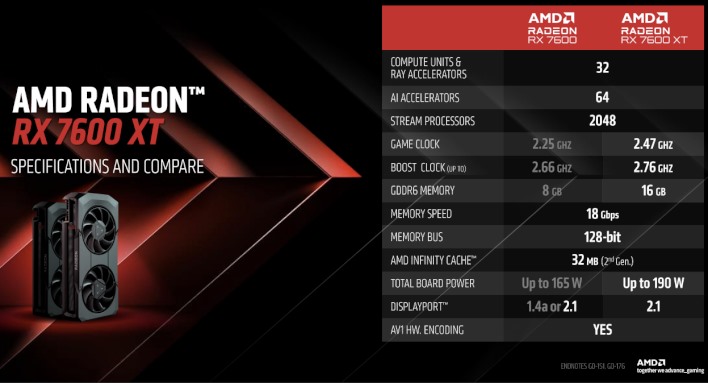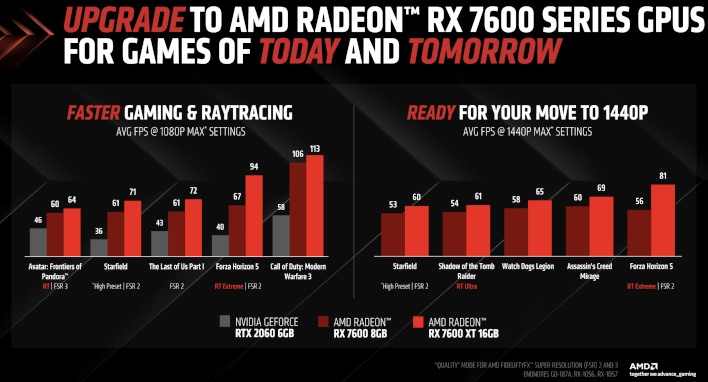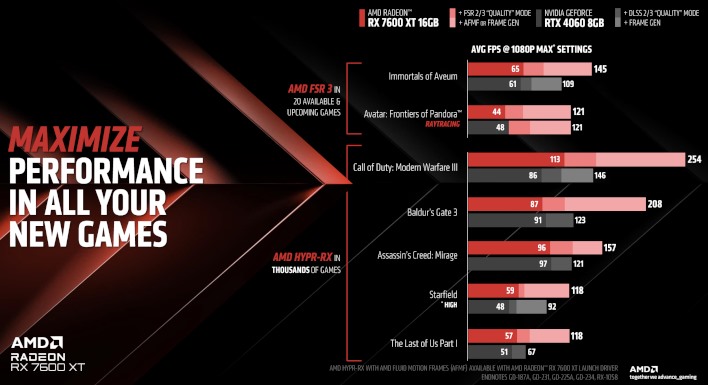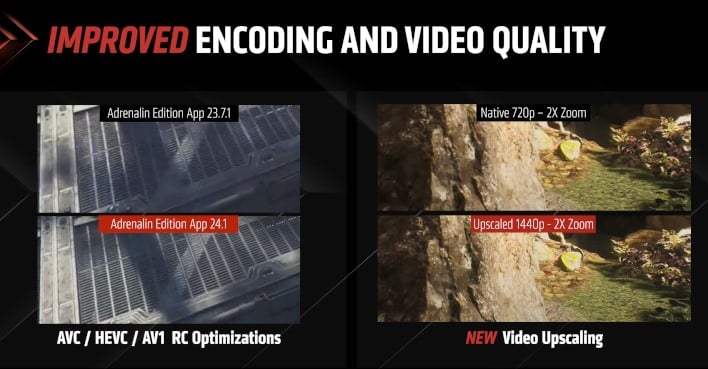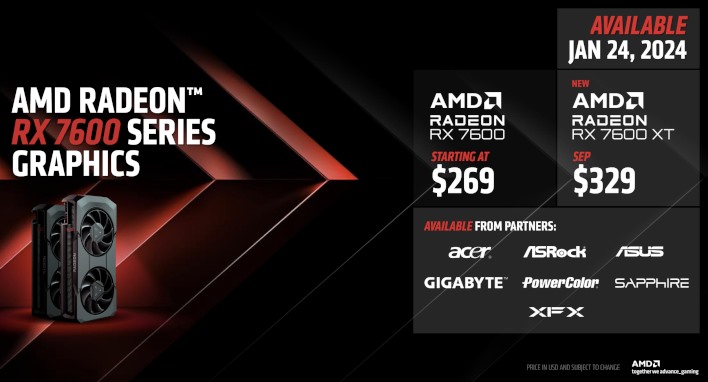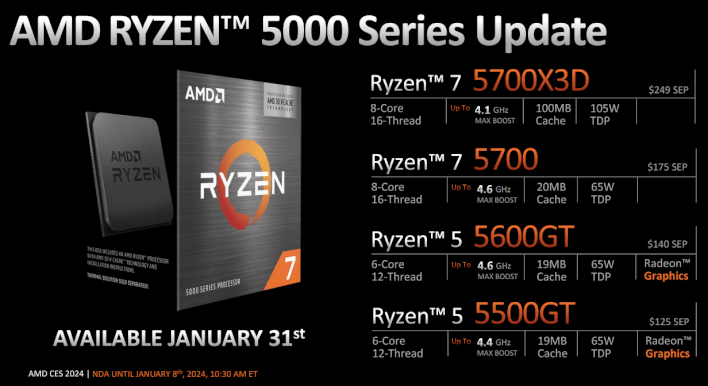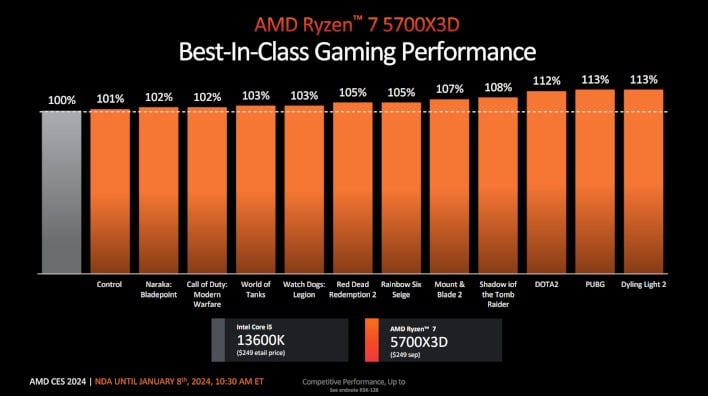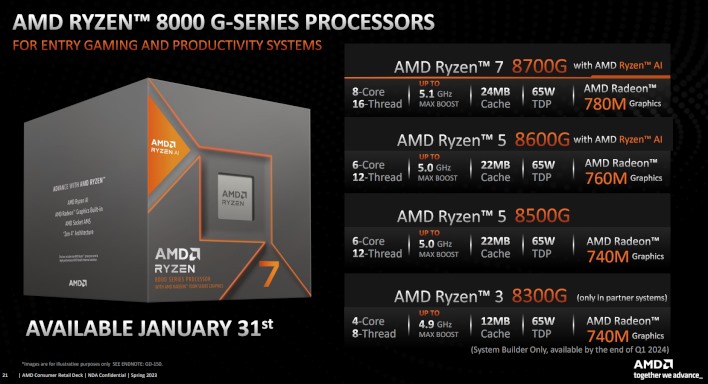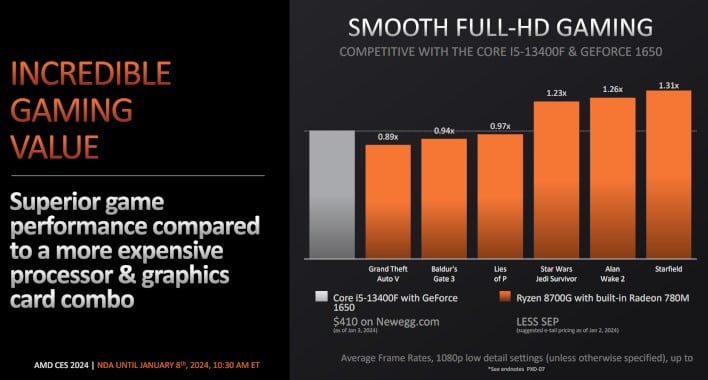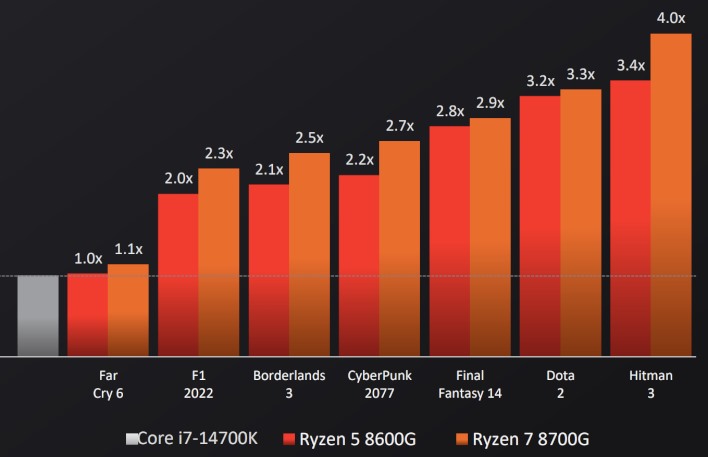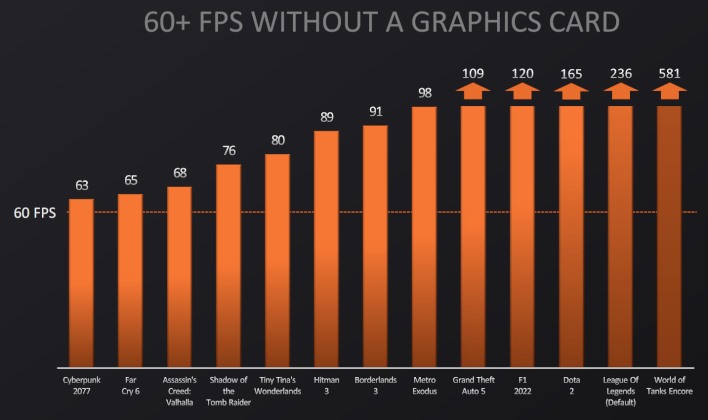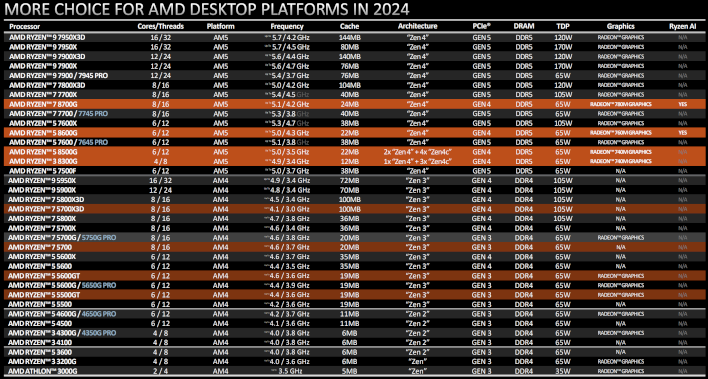Today's Consumer Electronics Show marks the first time
in three years that AMD hasn't brought a whole new lineup of mobile CPUs to Las Vegas. That's not because AMD doesn't have new mobile CPUs, rather the company already launched them just last month. The Hawk Point mobile processors, which are essentially Phoenix with an improved NPU, will hold the line for AMD's mobile offerings for now.
Instead, AMD's got a few other interesting products to announce at this year's CES, including some new desktop chips for both Socket AM5 and Socket AM4. There's also an updated graphics card as well as the announcement of a revision to the company's
AMD Advantage program. We'll start with that, since it's arguably the simplest.
If you're not familiar, "AMD Advantage" is a label that AMD's partners can apply to products that were produced in cooperation with the chipmaker. They'll feature Ryzen CPUs and Radeon GPUs, and there is a rigorous AMD certification progress involved. Now, AMD is renaming the
original AMD Advantage program to "AMD Advantage Premium," and adding another tier (simply called "AMD Advantage") below that.
The new, entry-tier AMD Advantage badge still requires that manufacturers enable
AMD's smart technologies, and also that they hit certain performance metrics. Manufacturers have to submit proof of these accomplishments to AMD, at which point they'll be given the green light to slap the AMD Advantage badge on their systems. Unlike the Premium tier, manufacturers don't have to send the systems to AMD for the red team to do its own validation.
AMD says that laptops bearing the Advantage badge will still offer consumers a great computing experience, with solid gaming performance and high power efficiency. No word on whether the Advantage badge will require laptop vendors to ship machines with dual-channel memory or NVMe storage, like Intel's Arc Graphics badge requires.
AMD Gives Navi 33 A Shot In the Arm With 16GB of GDDR6
Speaking of graphics, let's check out this new Radeon SKU from AMD. It's exactly what what you think: an "XT" version of
the Radeon RX 7600. The changes to this part from the original recipe are overall minor: an extra 220 MHz of GPU core clock, and an upgrade to 8GB of RAM comprise the important differences, although XT models will also be able to draw a bit more power—up to 190W from 165W—and they're also required to support DisplayPort 2.1, which was optional on the original RX 7600. Overall, it looks like a solid addition in the mid-range segment.
AMD's benchmarks in its slide deck compare the Radeon RX 7600 XT against NVIDIA's
GeForce RTX 4060 as well as against the GeForce RTX 2060. The latter is because AMD says that half of all Steam users are using a GPU that is equivalent or worse in comparison to the GeForce RTX 2060. Unsurprisingly, the Radeon RX 7600 XT is much faster than the old Turing GPU; AMD highlights what a great upgrade the new card would be for those people.
Against the GeForce RTX 4060, the story is less clear-cut, but AMD is perhaps taking a page from NVIDIA's book here and showing that its part is faster than the competitor's card when both have frame generation enabled. It's a pretty interesting comparison because the GeForce RTX 4060 does actually compete well with the Radeon RX 7600 XT with only upscaling engaged. The comparison is really more showing that
AMD's frame generation gives a bigger uplift than NVIDIA's.
AMD also highlights the Radeon RX 7600 XT's performance at 2560×1440 resolution, where it more conclusively and more consistently outperforms the GeForce RTX 4060. Interestingly, AMD presents some benchmarks in games that don't support DLSS, namely
Avatar: Frontiers of Pandora (on the previous chart) and
Like A Dragon Gaiden: The Man Who Erased His Name. Here, AMD demonstrates that NVIDIA's card benefits from its open-source technologies, too.
Along with launching the new GPU, AMD notes that it has made significant improvements to its Advanced Media Framework. In the past, the company has been criticized for the
less-than-stellar video coming out of its hardware encoders. Now, the company says that it has made ratecontrol optimizations that should radically improve the image quality out of its hardware encoders, especially in scenes with fast movement or fine detail. We might have to do some testing of our own on this front.
The new card is going to slot in between the Radeon RX 7600 and the Radeon RX 7700 XT at $329. The current card is keeping the pace at $269, although we've found it to be a bit cheaper than that on the street. While $329 a little expensive for the game performance you get, it's a decent value for a 16GB graphics card with AMD's software support behind it. Intel's Arc A770 has been cheaper than that occasionally, but it's a bit more hit-or-miss than a Radeon card, as we showed in our recent review of the
Acer Predator BiFrost Arc A770.
New AMD CPUs For Both Socket AM4 & Socket AM5
For CES this year, AMD's bringing out an eclectic collection of new CPUs. Surprisingly, fully half of the new models are actually for the company's previous-generation AM4 platform. Since those are arguably less exciting than the brand-new Socket AM5 chips, we'll get them out of the way first.
AMD says that the Ryzen 5 5500GT is actually a six-core CPU, not a quad-core.
As you can see, there are four models. The Ryzen 7 5700X3D is the only one of the three that's based on "Vermeer," the original Ryzen 5000-series CPU design. It sports eight Zen 3 cores, 16 threads, and 3D V-Cache for a total of 100MB of combined L2 and L3 cache. In fact, the only two differences between this chip and the original 3D V-Cache CPU,
the Ryzen 7 5800X3D, are that this one runs 400MHz slower on base and boost, and notably the MSRP on this part is just $249, fully $200 cheaper than the Ryzen 7 5800X3D. AMD says that the extra 400MHz of CPU clock barely matters in games, and that this part can still outrun a Core i5-13600K.

Meanwhile, the Ryzen 7 5700, Ryzen 5 5600GT, and Ryzen 5 5500GT are based on the monolithic Cezanne silicon. Technically, the Ryzen 7 5700 isn't actually new; it's been around as an OEM-only chip for a while. It is fundamentally identical to the Ryzen 7 5700X, except that that part is Vermeer and this one is Cezanne. That means a downgrade to PCIe 3.0 instead of 4.0, and the loss of half of the L3 cache leaving it with 20MB of total cache. This should still be a pretty quick CPU, though; certainly not bad for its $175 suggested retail price.
Unlike the Ryzen 7 5700, the Ryzen 5 5600GT and Ryzen 5 5500GT actually retain the Cezanne die's integrated graphics. The 5600GT is essentially a higher-clocked version of the Ryzen 5 5600G. AMD hasn't elaborated on the GPU core configuration and whether it differs from the Ryzen 5 5600G, but it gains 200MHz of CPU boost, anyway. On the other hand, the Ryzen 5 5500GT seems to be fundamentally the same thing as a Ryzen 5 5600G with very slightly higher GPU clocks. While the slide above marks it down as a quad-core, it is in fact still a six-core, twelve-thread CPU.
Ryzen 8000 G-Series Processors Bring RDNA 3 To Socket AM5
Finally, the biggest news of the day is the announcement of the first APUs for Socket AM5. Those are of course the Ryzen 8000G series that has been leaked (and which we've reported on) numerous times. The Ryzen 7 8700G and Ryzen 5 8600G are based on Hawk Point silicon, complete with an upgraded NPU, which also makes them the first socketed desktop CPUs with NPUs built in. The lower-end Ryzen 5 8500G and Ryzen 3 8300G are instead based on Phoenix 2, including that part's split of Zen 4 and Zen 4C processor cores; they miss the onboard NPU.
These parts take the revised Phoenix silicon and turn the power limit up to 65 watts, which we suspect (but have not verified) that you'll be able to unbind on overclocking boards. This means that not only do you get up to eight Zen 4 CPU cores boosting as high as 5.1GHz, but you also get that big six-WGP RDNA 3 Radeon GPU, which gets cut down to four WGPs in the Ryzen 5 8600G and just two in the 8500G and 8300G. Clock rates on the GPUs are higher on the desktop parts than the mobile parts, which probably explains this slide:

AMD compares gaming on a Ryzen 7 8700G's integrated Radeon 780M against the experience of using a Core i5-13400F with a GeForce GTX 1650. The company notes that the performance is broadly comparable despite the Ryzen 7 8700G costing considerably less than the CPU and GPU combo, not to mention drawing less power. The 8700G machine is using DDR5 memory at 6400 MT/s, and it's likely that these parts will be able to clock it even faster thanks to their monolithic design. Every little bit will help with gaming performance due to the shared memory interface.

AMD also compares its Hawk Point integrated graphics, for both the Ryzen 7 and Ryzen 5 models, against the Core i7-14700K. That's not Intel's fastest desktop CPU, but it has the exact same graphics processor as the Core i9-14900K. According to AMD's benchmarks, it dominates the Intel chip in every title, sometimes by as much as 4x the performance. Of course, we have to point out that the 14th-generation processors are still using the same Xe-LP graphics from the 11th-gen.
Ryzen 7 8700G benchmarks in 1080p with low settings.
AMD is upfront about the fact that, for general productivity tasks, a Raphael processor with a higher core count will generally offer better performance. Likewise, for discrete GPU gaming, a Raphael-X3D chip with 3D V-Cache will be your best AMD choice. For serious AI processing, you'll definitely want a GPU rather than the integrated NPU here. Of course, the company has options to fulfill whatever you need.
However, these parts are notable for being a single-chip solution that will probably serve the needs of just about any casual user, from productivity, to gaming, to AI. Moreover, they're upgradeable, and
unlike the last-gen Ryzen 5000 APUs, they don't force a PCIe version downgrade—you still get the full-speed PCIe 5.0 interface with these parts. UPDATE: Unfortunately, AMD has advised us that the Ryzen 8000G series does in fact step down to PCI Express 4.0, so even if you install one of these into a big-boy X670E motherboard, you'll still be limited to PCIe 4.0. However, that's unlikely to have a big effect on GPU performance.
All eight of the new CPUs, including the four Socket AM5 chips and the four Socket AM4 parts, will be available at the end of this month, on January 31st. The Radeon RX 7600 XT is coming a week earlier, on January 24th. Finally, systems sporting the new AMD Advantage branding should be coming out as you read this.


